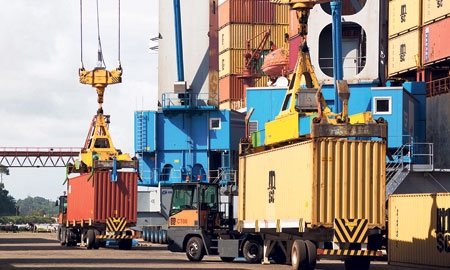A 9.8 per cent rate of growth in 2012 testifies to the dynamism of the Côte d’Ivoire economy and the
Port of San Pedro clearly demonstrates the kind of intelligent and effective decisions made and actions taken on the ground to contribute to this success and to lay solid foundations for continued future expansion.
To bring about the recovery from several years of political instability, the government launched a reconstruction programme focused initially on roads and basic social infrastructure, thus creating jobs and laying the foundation for sustained economic growth. Ports constitute an essential part of the country’s economic infrastructure and San Pedro has risen to the challenge, almost quadrupling its port tonnage over the last three years.
Director General Hilaire Lamizana attributes the port’s exceptional success to its aggressive growth strategy around three specific areas. The first was to firmly consolidate its traditional activity, the export from hinterland products such as cocoa, coffee, rubber, palm oil and wood.
The second sector identified was the development of the container terminal, with an ambitious regional vocation and with MSC (the world’s number two container shipper) holding the concession. The container terminal now occupies five hectares with a new container yard now planned to add 23 hectares more. Container traffic has grown from only 67,000 tonnes in 2010 to close to 2 million tonnes in 2013. Further plans include the construction of three kilometres of wharfs so that very large vessels of up to 260,000 tonnes can be accommodated, bringing annual capacity to above 20 million tonnes.
“Prior to 2011, traffic through the port never reached 1 million tonnes. By October 2013, it was already at 3.5 million tonnes”
Hilaire Lamizana, Director General of the Autonomous Port of San Pedro |
The port’s third objective has been to identify and develop new activities and new non-traditional sources of traffic, thus establishing San Pedro as the natural port of choice for products such as rice, cotton, cashew nuts and fertilisers from Mali, Guinea and also much of Liberia. This sector has now grown to 1.2 million tonnes annually.
Impressive as all of this is, Mr Lamizana says that the port’s ambitions go much further. Development plans include the establishment of a hydrocarbons storage facility of up to 500,000 tonnes in capacity, the creation of a large-scale fishing port, and a major project to ship through San Pedro iron ore and manganese from mines in the west of the country, a project which will also involve the building of a dedicated railway 600 kilometres in length.
Recognising that quantity also needs quality, the port boasts several ISO certifications and aspires to provide services comparable in quality to those in ports in Europe, while an ambitious commercial partnership has also now been established with the port of Antwerp.
Mr Lamizana reminds us that “the port now handles 10 per cent of Côte d’Ivoire’s foreign trade and brings work – directly or indirectly – to about 40,000 people”, thus representing a true success story and a great credit to its directors and all its staff.

0 COMMENTS